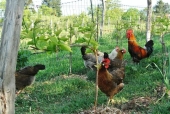Almost every backyard chicken raiser feeds purchased grain produced by eroding the soil and pouring on chemical pesticides, herbicides, and fertilizers. I worked for a farm that had a large pastured flock that was reasonably well managed on good quality pasture with daily rotation, and the hens still ate 1/4 pound of grain a day.
For those playing at home, the average confinement cage layer set up feeds 1/4 pound of grain per bird per day. Although the pastured birds produce a better tasting egg with more micronutrients from the foraging of green plants and legumes, it is an ecological wash. The extra calories from forage and insects went into fueling the chicken-like activities of the chicken. In essence, on any kind of agricultural productive scale beyond the feeding of food scraps and natural foraging of a couple of birds per household, pastured chickens are an ecological wash.
Pastured broiler birds killed for meat have an insignificant reduction in grain per pound of gain. Once again, it is a better tasting and more nutrient dense product, but on even a moderate commercial scale it still takes conventionally produced corn and soybeans to make it happen.
Rabbits or sheep would make a much more naturally productive animal in a perennial system. A handful of chickens on a big back yard and food scraps are fine, but will never yield close to the same amount of protein with only raised inputs that grazers will in the higher rainfall cool grass regions of our country.
If you have to have chickens, you could plant pure stands of clover, lay down boards to kill it off in 8" strips, and then hand plant kernels of short day #2 yellow corn, milo, pearl millet and sunflower to make your own blend for birds. You can then
compost all of the grain and oilseed plants in the fall, or if you had rabbits or sheep you could graze or cut/feed all the crop residues. The clover will produce your nitrogen needs, and the mulch of the kill strip will hold moisture and soil, and fill back in with clover as the grain and oil seed crops rise above it. I'd late summer over seed daikons and purple top turnips to scavenge nutrients and provide root crop feed in the late fall and winter as well.
If you are interested in coming up with a real productive plan that could produce a large amount of food, let me know. I've run a variety of productive agricultural and ag related enterprises over the decades.













 1
1





















































